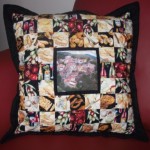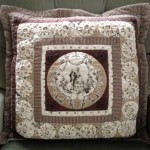I have been writing about quilts for many years. Most of my articles have been published in the quarterly magazine, New Zealand Quilter (N.Z.Q.). If I remember rightly, my first article was published in issue 2 – and we’re reading issue 87!
My articles are mostly reviews of exhibitions or commentaries on particular quilts and, occassionally, a ‘think piece’ such as “Judging Dilemmas” (issue 83) in which I pondered the challenges of being a judge of a major exhibition.
N.Z.Q. is widely distributed in New Zealand, and I remember Jenny Bowker – one of Australia’s leading quiltmakers – saying as part of her opening address at the Symposium in Wellington, that she thought that N.Z.Q. was “The best quilting magazine in the world – bar none”! Which was, I feel, well deserved acknowledgement of the acumen, effort, ability and success of Anne Scott. With the large distribution and high standard of N.Z.Q., I realise that what I write can be of significance, and a glowing mention in the magazine can do wonders for a quilter’s morale.
I try not to be critical of any particular quilt and so select quilts that I can write about positively – and there are always plenty of those. My reviews are not ‘critiques’ of quilts. (This is, I might add, an area of quilting that receives little attention, yet I feel that the work of many quilters – if they submitted their work voluntarily – could be enhanced by a rigorously honest critique.) However, I realise also that what I don’t write about can also be significant, for example, it is inevitable that some quilters will be disappointed when I don’t mention their quilts.
It must be acknowledged that all assessments of quilts are largely subjective, and that objective aspects play a very small part. One facet that could be judged objectively is technique, but this is not usually relevant as the technical competence of N.Z. quilters is generally excellent, and reviews which focused on technique could be very boring. The assessment of aspects of colour, tone, line, solid, balance, setting and bordering, fabric choices, etc. are also aspects that might be judged objectively but, because they are so interrelated and co-dependent within a work, this becomes much more of a subjective than an objective assessment. Also, I believe that the elements that lift a quilt above the ordinary are design and creativity; and design is dependent on subjective assessment in relation to socio-cultural factors, and creativity is largely a matter of the reviewer’s experience of what is and what is not original in quilting.
My main personal interest is in creative quiltmaking, and I really enjoy writing about ‘leading edge’ quilts. However, I attempt to balance this with articles about more traditional work, though I must admit that even here my focus is on the more creative interpretations.
My reviews of quilt exhibitions are never just annotated lists of award winners. Nor do I feel bound by the exhibition judges’ choices in regard to the quilts I write about; I act as my own selector and write about pieces that appeal to me, whether or not the judges’ concur. I realise that this places me in a very privileged position.
Publication in N.Z.Q. requires that I write to a word limit – which is my greatest challenge! This also means that I am faced with having to decide whether to make a brief mention of many quilts, or fuller comments on a smaller number of quilts. As I feel that a brief mention conveys almost nothing about the individual quilts nor about the exhibition as a whole, I nearly always choose the second option.
I really enjoy being able to write an occasional article about one particular quilt, such as: Sunday Night Jazz by Brenda McPartin (issue 83), My Turkish Plate by Valda Sutton and Land Use Change in Canterbury by Donna Rowan (both in issue 85), and Set Adrift by Sonya Prchal (issue 86). I have really appreciated comments from readers such as, ‘I didn’t like that quilt when I saw it in the exhibition, but your article gave me a different way to look at the quilt and now I can see a way to appreciate it’.
But perhaps my greatest delight has been writing about solo exhibitions. There are not many of these, but I have really enjoyed Katherine Morrison’s “Historical Context” exhibition in Otaki (issue 83), and Norma Slabbert’s “Walled Garden” exhibition in Hamilton (issue 86).
As well as writing about particular quilts I try to construct each review about a theme – to give an overall ‘feel’ of the exhibition, to give cohesion to the review, and to discuss an issue pertinent to quiltmaking that has a wider relevance than just this particular exhibition.
I have written reviews of several of the big Symposium Exhibitions and, in previous years, have written long articles about ‘large’ and ‘small’ quilts. Although I was pleased with these articles, I felt that dealing with many disparate quilts in one article made it difficult to make the reviews cohesive. So, when writing my reviews of last year’s Symposium Exhibition I wrote more, but shorter, articles about quilts that had a common quality: ‘thought provoking quilts’ and ‘a sense of place’ (both in issue 85) ‘playfulness’, ‘in a quiet voice’, ‘traditioned re-imagined’ (all in issue 86), and ‘floral Quilts’ (issue 87).
Finally, you may wonder what my qualifications are for writing so many reviews. Well – I made my first quilt in 1979 and have been quilting steadily ever since; and, at the moment am on a making-quilted-cushions-as-gifts binge. I also have an academic background to the visual arts as, when I was aged in my fifties, I began studying art history at Victoria University in Wellington, going on to complete my Masters in Art History. And, above all, I enjoy visiting lots of quilt shows and I then writing about them!
At present, I’m on a making-quilted-cushions-as-gifts binge!


Later in the year, I will write about my strategy when visiting quilt exhibitions for the purpose of writing a review about them.
